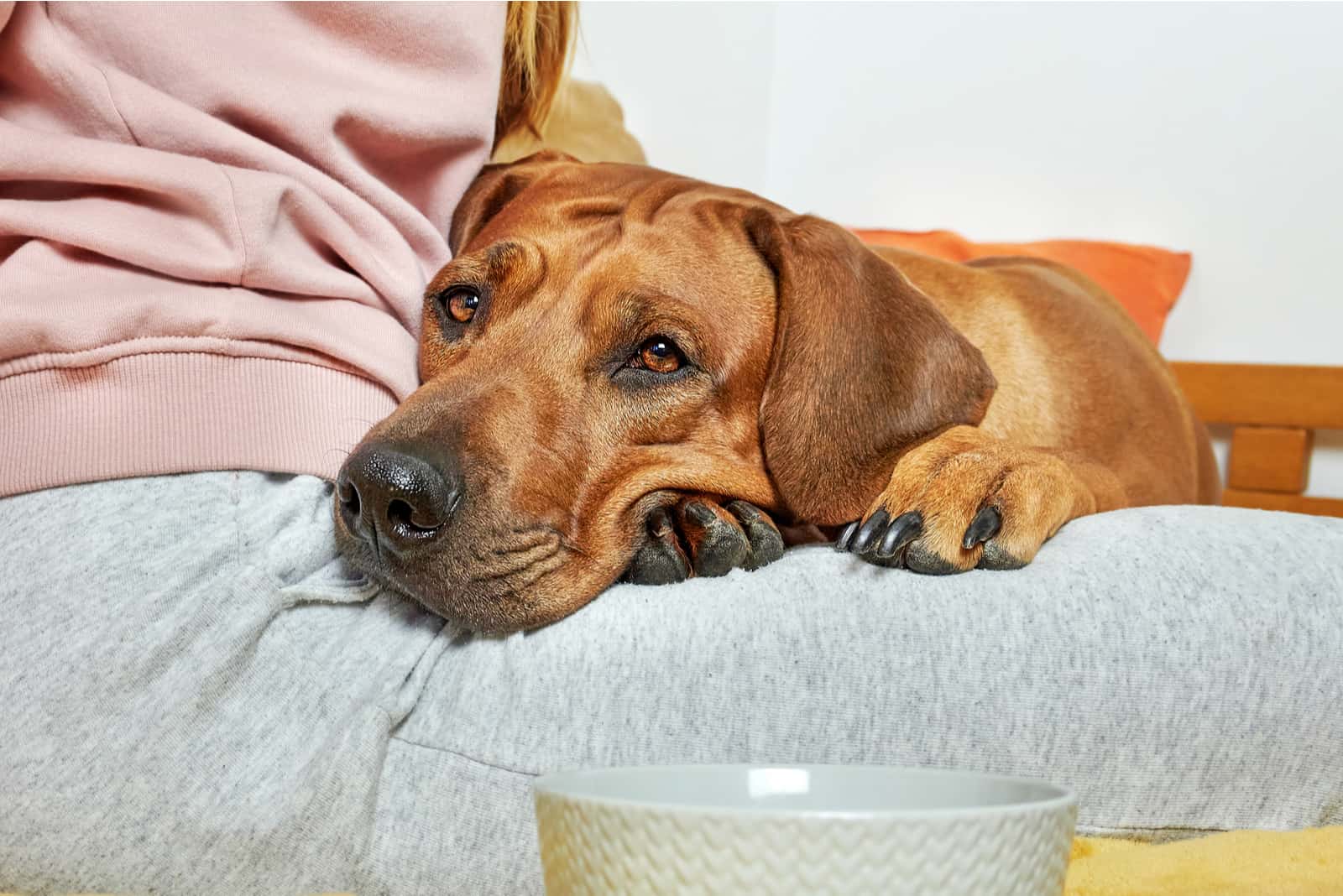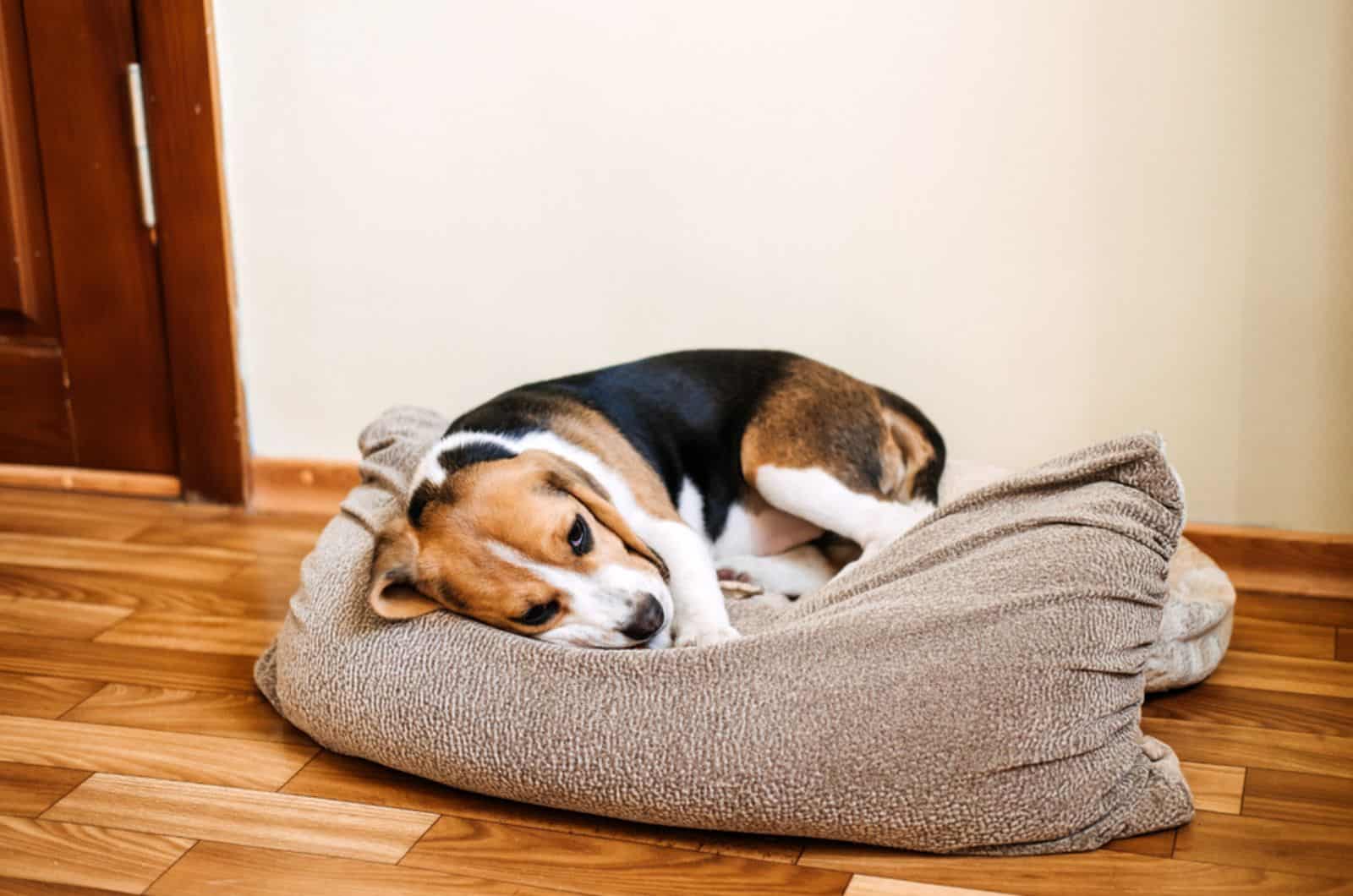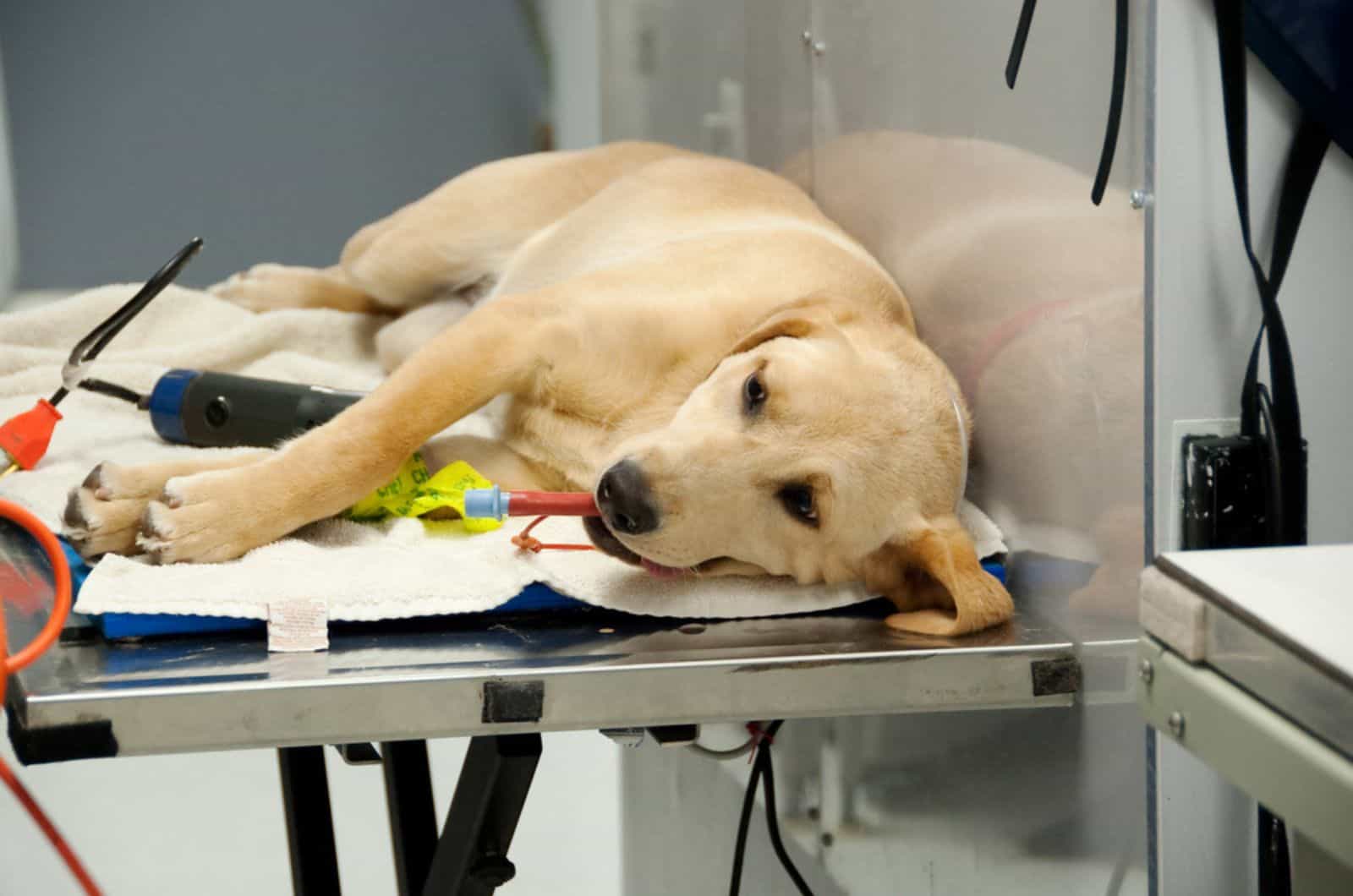Nobody wants to see their puppy or adult dog suffering after getting a vaccine that is supposed to help. Every dog will have its own “health baggage”, and the same goes for dog breeds — you never know what might happen.
Dog behavior change after vaccination is nothing new, and in most cases not cause for concern. However, there are situations where things get worse without dog owners knowing why. This is where I hop in and tell you about the things you need to pay attention to.
We will go through the most common and least severe first. The later part of the article will deal with serious and possibly life-threatening reactions or conditions that can affect the dog after receiving its vaccine.
Most Common Dog Behavior Changes After Vaccination

Despite what I tell you about certain symptoms and conditions, as a pet owner, you will still worry. It is a living being we are talking about, and caring for it carries the responsibility of worrying about things.
Understanding the way things work in the dog’s body will help rationalize the symptoms for you and alleviate at least some concern. The large majority of behavioral changes fall into the category of mild side effects.
Rare cases of serious adverse reaction can happen after your dog goes for a core vaccination. Such a situation can happen with distemper, parvovirus or rabies vaccines. Each can have a specific set of side effects that can help you deduce what is going on.
With any vaccine, especially the first one, you will probably notice a change in your dog’s usual behavior. The side effects can cause it to become drowsy, disinterested, refuse to eat or avoid physical contact.
The most common reactions to the vaccine will include sneezing, shivering, fever, lethargy, loss of appetite and general weakness. These symptoms and behavioral changes typically occur within half an hour after receiving the shot.
A Little Bit About How Vaccines Work
Vaccines essentially trigger the dog’s immune system to familiarize the body with the composition of the virus. Although many people say it is a “weakened form” of the virus, that is not always the case.
Sometimes it can be a protein (the part of the virus that enables it to attach itself to the host) that is injected. This is similar to a mugshot — the antigens will recognize the protein or weakened virus and start combating it.
Once the immune system educates the antibodies on the perp’s appearance the information is stored for use against future viral and bacterial infections.
The next round of shots will probably have a slightly different protein involved and the dose might be increased too. As the body grows, T-cells and B-cells become more apt at resolving infections which is why the vaccine composition has to be adapted.
Shots against canine bronchitis and leptospirosis last only a year, while a distemper vaccine can last for three years. The immune response wanes with time because the body is not routinely exposed to a particular virus, so not all vaccines are given annually.
Flu-Like Behavior As A Side Effect
If you recall getting your shots as a kid, you probably had a lousy time immediately after. Your dog will probably feel the same. A mild fever with some general irritability that gets worse closer to nighttime is to be expected.
A runny nose and a bit more drooling is a common side effect that follows vaccination. The dog’s body will be exhausted fighting off the infection, so your companion might be sluggish and decide to rest away from attention.
That is an instinctive response in dogs, to stay out of sight when in a weakened state. The eyes can be slightly watery and the gaze will tell you it wants to be alone.
Just like us humans.
This kind of behavioral change is almost unmistakably associated with bordetella bronchiseptica or kennel cough and parainfluenza.
The runny nose, sneezing and coughing happen because there is no injection — the administration is by drops or spray and that goes directly into the dog’s nose.
These are also known as intranasal vaccines.
The localized response is completely natural, but if your dog’s symptoms do not subside after a couple of days, it would be wise to visit a vet.
Drowsiness And Disinterest

Vaccinations can really kill the excitement in your day. I believe I speak for all dogs here when I say that refusing to play and moping around the house is a wasted day.
The disinterested and drowsy behavior can start on your way home too. The vaccine spurts the body into a swift reaction and the onset of symptoms is pretty quick too.
Disobedience and unexpected shyness are all normal after vaccination. Adult dogs will simply avoid activity or interaction with other pets or family members who are not in charge.
You can forget about fetch, tug of war, training and similar endeavors while your dog is trying to be in a minimum energy state. With more active dog breeds like the Labrador retriever, the change in behavior can be quite drastic. Do not worry, it is the vaccine.
Loss Of Appetite
Eating after a vaccine will be tough for the dog’s body. The immune system will use most of its energy to deal with the foreign bodies.
Digestion is an important part of the metabolism that converts food into energy, and that process alone is very taxing in terms of energy consumption. This is why dogs will be in a resting state to preserve as much body fuel to cope with the reaction to the vaccine.
No matter what food you give it, the dog might refuse eating it. Softer foods with more water content are recommended while the infection is active. It is also important to meet all dog needs, and that includes hydration.
Staying hydrated is essential for preventing complications. Make sure the bowl is full and near the dog.
Aggressiveness
Larger dogs will generally fare better after vaccination. Their changes in behavior will not be as dramatic as small dogs. Why do I say that? Research has shown that smaller breeds behave differently than large ones.
Their confidence levels are lower because of their size and the physically inferior position to most other living beings around them, hence their susceptibility to becoming aggressive after getting their shots.
Feeling exposed and threatened while in weak physical condition can lead them to snap at other pets or even you. This is nothing to be alarmed about, it is simply the way they are built.
My Belgian Malinois does not go through any behavioral changes after getting his annual shots, but a small mixed breed mutt my family had when I was a kid would despise everything and everyone for the rest of the day after getting her shots.
Of course, this type of behavior can be displayed by large breeds too. The pet’s relationship with its owner and family has an impact too. If it is an individualistic dog or breed, it might become annoyed when kids or other pets start disrupting their post-vaccine recovery.
I do not advise trying to calm them with physical contact or forcing any unwanted interaction. The dog will come when it feels like it requires your help or attention.
Read Also: Why Is My Dog Acting Weird All Of A Sudden: 17 Odd Dog Behaviors
Frequent Dog Vaccine Reactions
Some dogs do not experience behavioral changes but can still have side effects. This might strike you as odd because you presumed they would be lethargic or lose appetite.
Nope. Dogs are wonderful and unpredictable creatures. This is why some can deal with the infection more effectively than others. I wrote a short list of the most common side effects your dog might have whether behavioral changes were present or not.
Fever And Soreness
Fever is the most rudimentary of immune responses. The invading foreign body (virus or bacterium) is like a parasite — it will require ideal conditions to survive the dog’s body.
One of the parameters that are important for spreading in the host’s immune system is body temperature. Raising the body temperature creates an environment that the virus will not thrive in.
The body works the same way as an electric heater, so the dog will expend a lot of energy trying to increase the temperature. If your dog has a high fever of over 104.5, you will have to take it to an animal hospital.
Soreness mainly occurs at the injection site but can be non-localized too. The soreness will start very quickly after the shot is administered. The dog might cower or when touched on the injection site.
So, if you notice your dog showing discomfort when touched, do not leave the vet’s office, make sure the vet is aware of the fact. A cold compress can help alleviate pain if you are at home.
In case the home remedies do not work, you can visit a veterinary hospital and get some over the counter NSAIDs for your dog.
Knotty Mass Under The Skin
Lumps on the body can send shivers down your spine. In this scenario though, there should be no reason to worry.
A lump after vaccination is most frequently a localized tissue inflammation. That means it should not spread, get bigger, have liquid coming out of it or become more painful.
The inflammation occurs due to the sudden influx of leukocytes to the area. Injection sites are recognized as wounds by the body and white cells rapidly overflow the area to heal it. This creates a plug that remains trapped under the skin layers and becomes a lump.
Most often, the lump disappears within thirty days. If you see it worsened with time or did not disappear within the given time frame, call a doctor of veterinary medicine. Please note that this is not categorized as an allergic reaction.
More Serious Reactions

Unfortunately, not everything goes as smoothly as one would expect. Serious reactions include some life-threatening conditions such as anaphylaxis and autoimmune hemolytic anemia. However, these conditions are extremely rare.
Slightly less rare are skin irritation and swelling. Either one can be a symptom of a serious allergic reaction — anaphylaxis. It can often be fatal, but both symptoms can occur independently and are easily dealt with.
Skin Irritation And Swelling
These two reactions can be both mild and serious. Intensity and spread define the level of seriousness. If your dog appears to have a rash all over its body, not just localized around the injection site, then you should definitely rush it to the animal hospital.
Excessive scratching can be the sign that something is wrong, so make sure to inspect the skin for any redness or rash. Sometimes your dog might not know when to stop and create an open wound by scratching.
While in mild cases swelling mainly occurs around the injection site, more severe reactions can include facial swelling. This is considered a serious side effect requiring immediate medical attention.
These reactions are virtually always allergic reactions and visiting an animal hospital is recommended regardless of intensity. Preventing the reaction from advancing is better than trying to suppress it.
For this purpose, the doctor of veterinary medicine will prescribe antihistamines. These are inhibitors that reduce the amount of histamine the dog’s body produces.
If the reaction is serious, oral antihistamines such as Benadryl might not work fast enough or at all. Rushing your dog to the veterinary hospital as soon as possible will reduce the chances of suffocation from a swollen throat or airway.
The vet will probably administer intravenous antihistamines and keep the dog at the hospital for observation. Do not brush aside a small rash or swelling without calling your vet and describing the situation.
Anaphylaxis

Symptoms of anaphylaxis include quite a list of things. I have mentioned most of them in the previous parts of the article, but why not go over them once more. This time in context with the condition.
Instantaneous immune reactions to a specific allergen (vaccine content) will cause the dog to fall into an anaphylactic shock. In this state, the entire body is hypersensitive to the antigen and essentially tries to flush it out by overloading the immune system.
With anaphylaxis, it is important to note that initially, the rash, hives and redness might appear localized around the injection site. However, if your veterinarian is administering two shots in succession, the second vaccine might cause the dog to go into anaphylactic shock.
The latter is called systemic anaphylaxis and it is characteristic for insect stings. The first sting will be an alert to the immune system, the second a call to arms. Sometimes, the body is in panic mode and does not stop producing histamine.
When this occurs, the dog’s airways can swell up and cause difficulty breathing. Airway swelling is most commonly preceded by facial swelling. This happens (rarely) with intranasal vaccines.
The nostrils, throat and mouth are all directly exposed to drops or sprays of the antigen. Since these are vital segments of the upper respiratory system, the release rate of histamine in the body becomes too great for the body to properly distribute it.
Anaphylaxis is not a normal occurrence, and the hypersensitivity of a dog’s immune system is believed to be hereditary.
Other Anaphylaxis Symptoms
We discussed the rash, hives, redness, facial swelling and difficulty breathing. Still, there are more symptoms that are present in dogs with anaphylaxis.
Uncontrolled salivation happens because the body is trying to excrete the antigen and excess histamine.
Persistent vomiting occurs for the same reason as uncontrolled salivation — the body is trying to release the elements that are causing damage to vital organ systems. Vomiting is a fast way to try and reverse the damage antigens cause.
Diarrhea can be present after every meal a dog has or, in more severe cases, uncontrolled. The nutrients that reached the intestine are now being expulsed to carry the antigens with them.
Cyanosis is a condition where the blood does not contain enough oxygen. The body parts most frequently affected by cyanosis are extremities (especially fingers), lips or ears. If you notice your dog’s mouth is of a bluish tint, immediately rush to the veterinary hospital.
The blue color indicates that either the heart or the lungs are having trouble pumping oxygenated blood into the farthest points of the body.
Autoimmune Hemolytic Anemia (AIHA)

In this gush of leukocytes that are trying to stop the foreign bodies from damaging the vital systems, there will be collateral damage. We already talked about histamine production and how it can cause more damage than fix it.
Autoimmune hemolytic anemia is defined as the erythrocytes (red blood cells) being attacked by the immune system. At this point, the body is throwing the kitchen sink at the antigens in the hopes of mitigating damage.
However, the invasive and aggressive nature of white blood cells does not have time to distinguish what is a key part of the blood system and what is the foreign body, so it annihilates everything in its path.
The body cannot produce enough erythrocytes in the bone marrow to compensate for the dramatic loss of them throughout the body. The lungs and heart start having trouble properly functioning.
The hemoglobin which carries oxygen into the red blood cells has no carrier and the blood vessels deprived of oxygenated blood start constricting.
Since the body is programmed to redirect blood into the brain, heart, lungs and other vital organs in case of low blood supply, the peripheral organs such as the arms, legs, lips, nose and earlobes get reduced or non-existent blood flow.
Again, the onset of cyanosis can be pretty fast and, if the dog does not receive immediate medical attention, nerve damage, loss of organ functionality or death can occur.
The main symptom of this condition is gums and eyes that look jaundiced. In addition, the skin might also appear to have a yellow hue. Be on the lookout for dark urine, another major symptom. The color is caused by the leftover bilirubin from the dead red cells.
Allergic Reactions Usually Point To Secondary AIHA
Primary AIHA is congenital. It means the dog was born immunocompromised. Secondary AIHA is quite different. A particular antigen (in our case it is whatever the vaccine contains) will modify the surface of erythrocytes and make it unrecognizable for the leukocyte.
The immune system’s response is an attack and removal of the foreign body. The problem is that it was not a foreign body but an essential component of a normal body function. Leptospirosis vaccines are known to trigger AIHA in dogs.
Treating Autoimmune Hemolytic Anemia
The treatment will most certainly require hospitalization. The doctor of veterinary medicine will make sure to maintain a free flow of air through the dog’s airway.
Your canine companion will need to be under general anesthesia during hospitalization.
Another important aspect of treating AIHA is keeping the blood pressure stable. This directly affects the circulation of blood. If the dog had mild symptoms of AIHA or you took it to the DVM preventatively, not much damage will be done to the body.
In case of severe reactions, the damage will be quite hard or impossible to fix. Plainly said, the most important thing will be resetting the body to factory defaults.
Conclusion

It got pretty dark and dangerous near the end. I know we all worry about our dogs’ health. Vaccinations are an important part of both human and dog lives.
If the list of conditions and symptoms scared you, and now you are contemplating whether to vaccinate or not — do vaccinate your dog. These complications occur mostly in dogs that have poor genetic traits within the bloodline.
A good breeder will rarely produce a puppy with this kind of congenital condition. Still, if you have a rescue dog, you must be ready to accept the fact that all of this is a possibility. Thankfully, the more severe cases are extremely rare.
Noticing a dog behavior change after vaccination is harmless in the vast majority of cases. Just give it time to recuperate and continue with your happy lives.
I wish plenty of good health for you and your canine friend.
Read Next:
• 10 Reasons Why Dog’s Balls Are Red & How You Can Help
• How Serious A Lump On Dogs’ Tail Can Be: 9 Explanations















